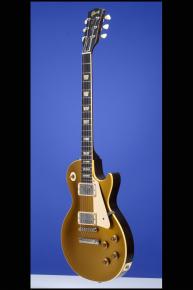One of the Very Last PAF Les Paul Standard Gold Tops
One of the very last PAF Les Paul Standard Gold Tops and one of the very few with a dark brown back! This guitar weighs just 8.80 lbs. and has nice, fat nut width of just over 1 11/16 inches and a standard Gibson scale length of 24 3/4 inches. Solid "dark-back" mahogany body with a solid carved maple top, one-piece mahogany neck with a medium profile, and rosewood fretboard with 22 original medium to thin frets and inlaid pearl trapezoid (crown) position markers. Headstock with inlaid pearl "Gibson" logo and "Les Paul Model" silkscreened in gold. Two-layer (black on white) plastic truss-rod cover. The serial number "8-2700" is inked-on in yellow on the back of the headstock. The top of the guitar has single-ply cream binding and the fretboard has single-ply cream binding. Individual single-line Kluson Deluxe tuners with single-ring tulip-shaped Keystone plastic buttons (stamped on the inside "D-169400 PATENT NO."). Two PAF humbucker pickups (double-black) with outputs of 8.00k and 7.80k. The cream neck pickup mounting ring is stamped on the inside "MR491" and "M-69 7" and the cream bridge pickup mounting ring is stamped on the inside "MR490" and "M-69 8." Single-layer cream plastic pickguard. Four controls (two volume, two tone) on lower treble bout plus three-way pickup selector switch on upper bass bout. Gold plastic bell-shaped "Bell" knobs. The potentiometers are stamped "134 808" (Centralab February 1958). Two original "Bumble-Bee" capacitors. With the original black plastic control cavity plates. ABR-1 non-retainer Tune-O-Matic bridge with metal saddles and separate stud tailpiece.
This forty-nine-year-old one of the very last of the PAF Les Pauls has had the body and the back of the neck refinished by Tom Murphy. With a handwritten letter, signed by Tom Murphy, which reads: "To whom it may concern, Regarding Gibson Les Paul guitar serial #8-2700, I found this to be an authentic Gibson instrument from 1958. The original serial # was recorded by being stamped into the neck pick-up cavity. The finish has been redone by me in a vintage style gold-top 'dark' walnut back, with subtle aging to match hardware to finish. All of the hardware, pick-ups, tuners, plastic, etc., are original to this instrument. Output readings of the 'patent applied for' pick-ups are 7.8 on the bridge and 8 on the neck. The frets are original and untouched."
There is a little bit of fretwear, mainly to the first seven frets, and a couple of tiny marks, but this guitar plays, sounds, and looks phenomenal, and is in near mint (9.25) condition. In our opinion, the neck pickup cover solder joints have been redone at some time, but the bridge pickup cover solder joints are certainly original. Housed in the original Gibson brown four-latch "California girl" hardshell case with pink plush lining (9.00).
09/13/10. Post Script: In early September the guitar was examined by Paul Flynn of Truetone Music in Santa Monica who noticed evidence of a small headstock crack/repair. On September 10, 2010, Fretted Americana contacted Tom Murphy asking him if he had any knowledge of any headstock crack/repair when he re-finished the guitar in 2006/2007. In an email dated September 13, 2010, Tom Murphy states "As I stated in our phone conversation, the small headstock repair existed prior to the refinishing work I did. The customer that I did the work for was Jimmy Wallace. He had knowledge of the headstock issue at that time."
"The new Les Paul guitar was launched by Gibson in 1952, in the summer, priced at $210, which was about $20 more than Fender' Telecaster sold for at the time…Today, a gold-finish Les Paul model is nearly always called a gold-top thanks to its gold body face…The new gold-top's solid body cleverly combined a carved maple top bonded to a mahogany base, a sandwich that united the darker tonality of mahogany with the brighter sonic 'edge' of maple. Paul said that the gold colour of the original Les Paul model was his idea. 'Gold means rich,' he said, 'expensive, the best, superb'" (Tony Bacon, 50 Years of the Gibson Les Paul, pp. 20-21).
"In 1955 the gold-top gained Gibson's new Tune-o-matic bridge. The unit had the facility to adjust individual string-length, improving intonation. Two years later humbucking pickups replaced P90s on the gold-top" (Tony Bacon and Paul Day, The Gibson Les Paul Book, p. 19).
"Some 1957 and 1958 Les Paul goldtops are seen with dark brown backs. These 'dark backs' are easy to identify by the serial number, which is ink stamped with yellow ink (instead of black ink, as used on the light color backed goldtops). Also darkback Les Pauls will have black control cavity plates (as used on the Les Paul Custom) instead of brown plates. Humbucking PAF pickups replace P-90 pickups around serial number '7 2000' to '7 3800' range (latest 1957 goldtop documented with P-90s is serial number '7 38xx', and the earliest is a leftie PAF goldtop '7 13xx'). During this period there was definately overlaps of Goldtops with either P90 or PAF pickups. First few months of humbucker pickup production used brushed stainless steel pickup covers (instead of nickel plated covers) with no PAF stickers. Resistance of the new pickups ranged from 7.0k ohms to 8.9k ohms. The first month of humbucker Les Paul goldtop production used black plastic parts (pickguard, pickup rings, switch surround), with black parts ending by about serial number '7 32xx'. All black plastic 1957 Les Paul Goldtops should have a dark back (if it doesn't, chances are someone stole the cream parts and replaced them with black parts). Within a month or two, PAF goldtops changed to cream plastic parts (cream part PAF goldtops not seen before serial number '7 3000'). Generally speaking black plastic part 1957 Les Paul goldtops are worth less than cream part 1957 goldtops though. The black and cream plastic humbucker pickup mounting rings had 'M-69' as part of the molding, on the bottom side between the height adjustment screw and mounting screw. Also the plastic humbucker rings had four 'screw tunnels' for each mounting screw (but not for the two pickup height adjustment screws). Though the M-69 pickup surrounds were used until about 1970 (in black, when they were replaced by the M-8 pickup rings with no screw tunnels), Gibson did not use cream colored M-69 pickup rings any later than 1960. That's why there's such a big deal about original cream-colored 1950s Les Paul pickup rings, because original M-69s in cream were unavailable after 1960. Though these seems like minor details, original plastic parts are important to these guitars" (http://www.provide.net/~cfh/gibson5.html#lpstd).
In 1958, the "model name changed from 'Les Paul Model' to 'Les Paul Standard'. Sunburst finish replaces Goldtop finish in the fall of 1958, around serial numbers in the '8 5300' range (though the first known Sunburst Les Paul has serial number '8 3322'). The maple top on a 1958 to 1960 Sunburst Les Paul is always two pieces and 'center seamed' (there is NO exception to this rule, except for one of the first 1958 sunburst Les Pauls with serial number '8 3322'; if a Sunburst Les Paul does not have a two piece center seamed maple top, it is a refinished Goldtop!) Most 1958 Sunburst Les Pauls came with a brown 'california girl' case with a pink lining and four case latches. But by the end of 1958 the cases changed slightly to have five latches, and this 5-latch brown case is known as the defacto-standard Sunburst Les Paul case" (http://www.provide.net/~cfh/gibson5.html#lpstd).
Translate:









